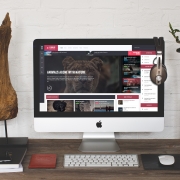Essential business website design principles
While we’ve covered the basic principles of website design and development, you may wonder “what specific principles for business web design can I apply to my site?” Sure, you’ve implemented the basics and used the best internet technology, but how can you utilise your website to make the best first impression?
For most businesses, their website is the first and sometimes only thing a potential customer will see before they decide whether to hire you or not. After securing the basics, think about incorporating some of these essential ‘best-impression’ tools below.
Keep up with, or be ahead of the times
You can no longer promote things as simple as mobile optimation, as now such things are a given – every website should have them. Even small businesses with zero online experience can put together a simple website and expect it to be optimised for mobile and tablet, so an established business website should definitely have this in place.
Is it “ergonomically designed”?
We’ve talked about ease-of-use before, and a simple, easy-to-use website is a necessity. But have you really thought about your customer’s experience when using your site?
While mostly used to refer to physical design, an ergonomic design simply means is it logical, and tailored to how a person would want, or expect, to navigate your website. Do you have logical steps set out, with the average customer’s journey in mind? For example, is your call to action for a product backed up with an easy option to click and buy that product? With everything at the tip of your customer’s fingers online, if your website is clunky or nonsensical to explore, chances are they’ll look at one that isn’t.
Professional and modern visuals
Is your website in-keeping with current design trends? When you compare it to others in your industry does it look dated? Or is it slightly ahead of the curve? Spend a little time researching current design trends, but identify what is a fad and look at the trends that seem to be defining the design industry. A good, current example of this is minimalism, and its application to the use of colour. Don’t be afraid to use bold colours…minimally!











Leave a Reply
Want to join the discussion?Feel free to contribute!